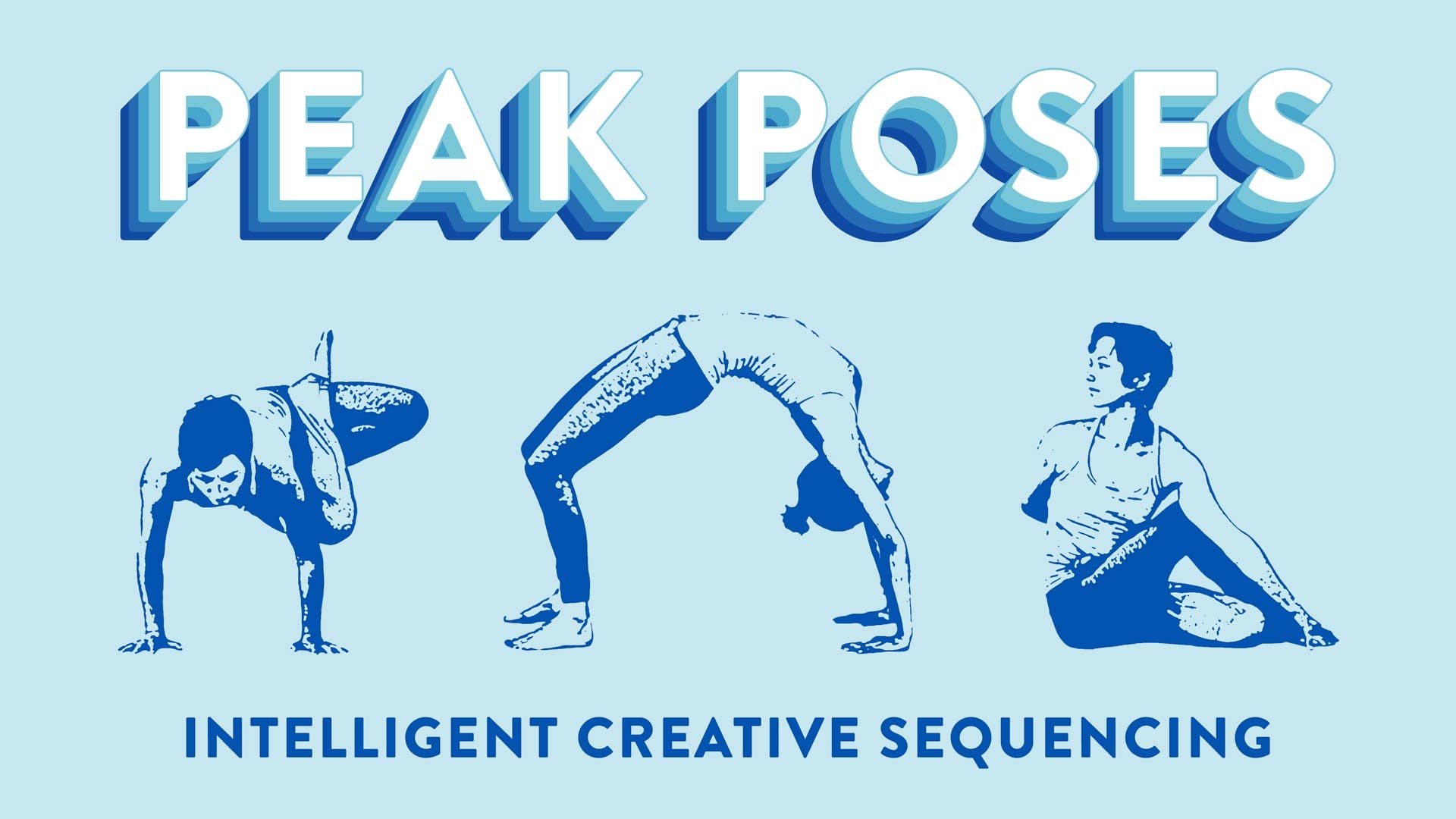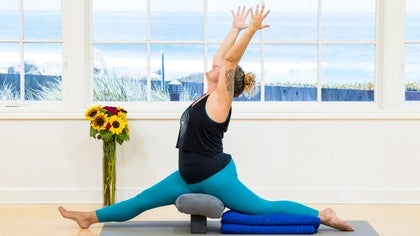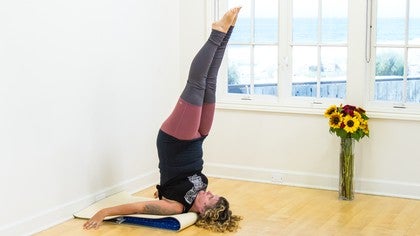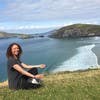Description
About This Video
Transcript
Read Full Transcript
Hi. Today we're going to work on Bird of Paradise, also known as BOP, the phrase from Jasmine Tarkeshi from Laughing Lotus, OMG BOP. So we're going to start standing and we'll take tree pose over Kshasana. So come to the front of your mat and ground through your feet. People will start to bring the weight more into our left foot until our right foot gets a little bit light. Finding that inner thigh line and somewhat softening through the outer glute. Taking your foot, it can start at the ankle, it can go to the calf, or it can come all the way up. You can use your hand to help. So there's a relationship between our standing leg and our foot. They meet each other. I like to say that they're kissing and both people are really into it. No one's pulling away. So foot and thigh like each other. They're pressing into each other. The femur on your standing leg moves away out of the socket and the inner thigh is moving away out of the pelvis down to the floor of the bottom leg. Bring your hands to your heart and we breathe here. So we're looking at the rotation of our hip here. So here in this pose with the thigh bone lower than our pelvis, a lot of us can get it pretty far out to the side. It changes once we start to bring the femur up higher, which is where we're going. So it's just good to know where you're at. If you can't get it out this far to the side in tree pose or if your foot needs to be lower down, these are things just to note about yourself. And then we'll try the other side. So rooting down through our right foot, letting the left leg get a little bit light, finding the strength of the supporting leg before you bring the other foot up. Again, you can do ankle, calf, or you can use your hand to grab a hold. So not letting this poke out to the side. This would be my foot making out with my thigh and my thigh not involved at all. So the two like each other. They participate. So my standing leg femur is right in the center above the ankle and I'm rooting through my inner thigh. It actually requires a lot of concentration to do so. And then inner thigh of the bent knee moving out through the knee. And the hands can come to the heart. They can also lift up. And you're breathing here. Noticing the difference. Are the two different? Is one leg tighter than the other? Is one side easier to get externally rotated? Is one side easier to lift up? Just taking note of those things, trying not to have any judgment about it. And then taking the feet back down to the ground. We'll start with upward salute here. You have space between your feet. I think that's fine. You can also have them together. I like to think about where our femurs are coming out naturally from our pelvis is a good distance. So grounding through inner thighs. Right? Even distance or even weight in the feet here. And then taking the arms on up overhead. Find some external rotation of the arms. And then lifting up from side body. I like to take the gaze up. There's a tilt of the pubic bone away from the navel.
So you're allowing the pelvis to move with that while maintaining that inner thigh strength. Reaching here. Find a breath. And then bring the hands to the heart here. I'm going to grab my blocks for arda uttanasana. So starting with arda. Right? Again, that distance between the feet can be really helpful. Finding the inner thighs rooting down. Right? Hip creases are both softening out to the sides and then through and out through the glutes. Right? While maintaining strong inner thighs. Press down through the blocks or if you can get your hands on the ground, great. Right? And extend through the spine. Right? So gaze not just goes in front of you, but it's going along and forward. Right? I keep rooting through inner thighs and I keep softening those hip creases while I'm doing this. There's another breath. Here. And then we'll come down into our downward facing dog. And I like to use blocks underneath my hands. If you haven't ever tried it, you should try it. Come into downward facing dog. Pressing down through first knuckle. Find some external rotation of the humerus, your upper arm bone. Ceritis right along the sides of the ribs. Moving towards the hands we're elongating. Slight arch the lower back. Grounded inner leg line. Hip creases moving out to the side and through the glutes. Trying to do all those things at once. Breathing here. Noticing what takes extra work. What you forget about. In particular, when you find that extension through the spine. Another breath here. And then we'll come down onto our knees and you'll need a blanket probably. It makes it just a little bit more comfortable to do this. Move my box out to the side for a moment. And depending on how much flexibility you have in your hips will depend on how wide you need to take your blanket. I'm guessing that this should be good for me today. But if you're pretty open in this way, you might need to unfold it even more. We'll come down. This is also called mandukasana or half froggy. You're going to bring your knees out to about as far as they can go. Right? And for some of us, we're going to want to bring our feet in. But for today, I'm going to ask you to keep them out to the side here. And this up on handprints might be like, hello, hi. Right?
And it might be more than enough. So you're going to be able to get out of the sensation two different ways. You get out of the sensation by moving back. You also can get out of the sensation by moving forward. So you're wanting to not do those things. Different people do different things. So notice what you tend to do. Right? I tend to go forward. So I know that I need to kind of go back. And you'll find the point where you're like, yeah, okay, that has more sensation. And you stay there. And then you might be able to bring the knees a little bit wider. This is a good indication of our limitation where bone meets bone. Right? In particular, when you get to that spot where if the sensation is above, so if the sensation is here, you're meeting your thigh bone with your pelvis. And no matter what you do, it might shift a little bit. But it's not ever really going to shift a lot. The sensation is in the inner thighs. That's tension. And that can change. Right? So just noticing where you have the sensation. For bird of paradise, which is pretty big, opening through the pelvis like this, these are good things to know about yourself. If you're getting bone on bone, you're going to have to adjust. Right? To make it work for your body. And not just keep pressing into something or feeling bad. Because it's not happening. Right? Learning to work with what you've got. So you breathe here. More is like an educational experience than anything. You take a few more breaths. I like to rock because it feels good. Right? I get a little bit into that spot of tension. And then I move away. And then I get a little bit in. And then I move away. And I can go a little bit further. Right? We're here for a few more breaths. Some people, right, they come out of the womb in this shape. And they're going to be flat down onto their belly. And that's great. For most of us, we're not. This is also a great indicator of your triangle pose too. Many poses here. So we want to come back up onto our hands if you came in. And you want to really slowly move your knees back in together. Right? Because you just took them out pretty far. And then sit onto your heels for just a moment to kind of ground everything. I like to actually push in on my bones. Right? To just remind them to go home. Go back. Go back where you belong, little bones. Right? And then we're going to come back into our downward facing dog. And I'm actually going to leave this blanket here because we're going to do shalabasana and it will feel really good. So I'll grab my blocks. And come into downward facing dog. I'm using this just to neutralize again. Trying to find my inner thighs. That extension through the spine. Taking a few breaths here. Noticing any differences. And then we'll come back down onto our knees. We'll move our blocks off to the side. And come down onto our belly for shalabasana. So it's nice to have a blanket underneath the belly with a pubic bone. Right? So that it's more comfortable. Hands come overhead. We find that reach. Inner thighs and side body. And then come on up, shalabasana. Keep reaching. Keep breathing. Take one more breath here. And then release. And we'll come back into our downward dog. This time I'll move my blanket out of the way. Grab my blocks again. And breathing here. Each one getting a little bit more yummy. Each one feeling a little bit more useful. Potentially. Potentially not. I'll start to walk my feet forward. And I'm going to come into a malasana variation or a Buddha squat. Sometimes having props here can be really nice. So some options are to have a block underneath your seat. Right? And you can work this with that support. Right? Pressing the elbows into the thighs. If your ankles don't come or your heels don't come to the ground, placing a blanket, taking your blanket, rolling it up. It might be like one or two rolls underneath the heels is nice. So here what I'm looking for is the ability to open our femurs out while maintaining extension through the spine. Right? So I'm using my arm to press into my legs. Right? So I'm opening, opening, opening through the legs. And then I'm lifting, lifting, lifting my heart at the same time. Because ultimately this is what bird of paradise is. One of the key actions of that shape. You can take a few breaths here. You can also do this without support. Right? If you're wanting a little bit more vigorous activity here. And then we'll come on down onto our backs. And we'll need a strap
Peak Poses: Jessica Garay
Comments

You need to be a subscriber to post a comment.
Please Log In or Create an Account to start your free trial.














